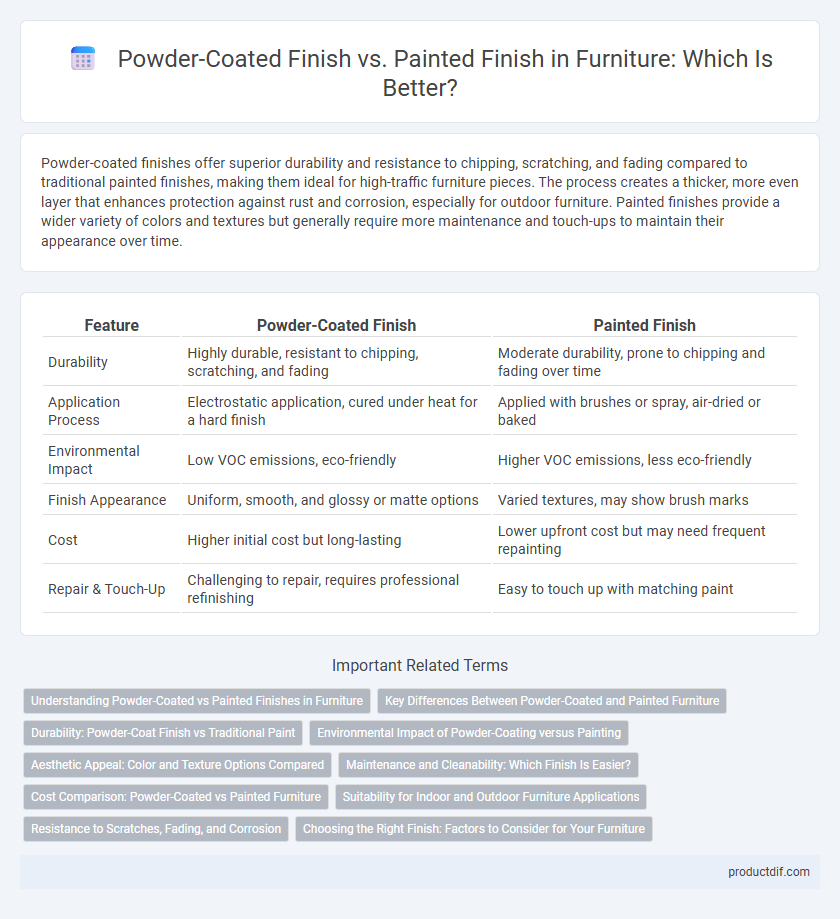Powder-coated finishes offer superior durability and resistance to chipping, scratching, and fading compared to traditional painted finishes, making them ideal for high-traffic furniture pieces. The process creates a thicker, more even layer that enhances protection against rust and corrosion, especially for outdoor furniture. Painted finishes provide a wider variety of colors and textures but generally require more maintenance and touch-ups to maintain their appearance over time.
Table of Comparison
| Feature | Powder-Coated Finish | Painted Finish |
|---|---|---|
| Durability | Highly durable, resistant to chipping, scratching, and fading | Moderate durability, prone to chipping and fading over time |
| Application Process | Electrostatic application, cured under heat for a hard finish | Applied with brushes or spray, air-dried or baked |
| Environmental Impact | Low VOC emissions, eco-friendly | Higher VOC emissions, less eco-friendly |
| Finish Appearance | Uniform, smooth, and glossy or matte options | Varied textures, may show brush marks |
| Cost | Higher initial cost but long-lasting | Lower upfront cost but may need frequent repainting |
| Repair & Touch-Up | Challenging to repair, requires professional refinishing | Easy to touch up with matching paint |
Understanding Powder-Coated vs Painted Finishes in Furniture
Powder-coated finishes in furniture provide a durable, uniform layer that resists chipping, scratching, and fading better than traditional painted finishes. This electrostatically applied dry powder is cured under heat, forming a hard, protective shell, whereas painted finishes often involve liquid paint that can be prone to runs and uneven coverage. For high-traffic furniture, powder coating offers enhanced longevity and a smoother texture, making it ideal for both indoor and outdoor applications.
Key Differences Between Powder-Coated and Painted Furniture
Powder-coated furniture features a durable, thick finish created by electrostatically applying powdered paint and curing it under heat, resulting in superior resistance to scratches, chipping, and fading compared to traditional painted finishes. Painted furniture typically uses liquid paint applied with brushes or sprays, offering a smoother, glossier appearance but less durability and susceptibility to wear over time. The environmental benefits of powder coating include lower VOC emissions and less waste, making it a more eco-friendly option than solvent-based painted finishes.
Durability: Powder-Coat Finish vs Traditional Paint
Powder-coated finishes offer superior durability compared to traditional painted finishes, providing a thicker, more resistant layer that guards against chipping, scratching, and fading. The electrostatically applied powder melts into a tough, uniform coating that withstands weathering and corrosion better than liquid paint. This makes powder coating ideal for furniture exposed to outdoor elements or high-traffic environments, ensuring longer-lasting protection and appearance.
Environmental Impact of Powder-Coating versus Painting
Powder-coated finishes significantly reduce environmental impact compared to traditional painting by eliminating the need for solvents and reducing volatile organic compound (VOC) emissions. The curing process in powder coating produces less hazardous waste and consumes less energy, making it a more sustainable option for furniture manufacturing. Powder coating's efficient application minimizes material waste, contributing to lower overall environmental footprint relative to conventional painted finishes.
Aesthetic Appeal: Color and Texture Options Compared
Powder-coated finishes offer a wider range of vibrant colors and smooth, uniform textures that resist chipping and fading, enhancing the longevity of furniture aesthetics. Painted finishes provide more customizable texture options, including matte, satin, and gloss variations, allowing for tailored visual effects and a handcrafted appearance. Both finishes impact color durability and texture consistency, but powder coating generally delivers a more durable and uniform aesthetic appeal in contemporary furniture design.
Maintenance and Cleanability: Which Finish Is Easier?
Powder-coated finishes offer superior durability and resistance to chipping, scratching, and fading compared to traditional painted finishes, making maintenance easier in the long run. Cleaning powder-coated furniture typically requires only mild soap and water without the risk of damaging the surface, unlike painted finishes that may peel or require touch-ups. This enhanced toughness and low-maintenance quality make powder-coated finishes the preferred choice for furniture exposed to frequent use and outdoor elements.
Cost Comparison: Powder-Coated vs Painted Furniture
Powder-coated furniture typically incurs higher initial costs due to specialized equipment and curing processes but offers greater durability and longevity, reducing maintenance expenses over time. Painted furniture generally has lower upfront costs with a wider range of color options but may require frequent touch-ups and repainting, increasing long-term expenses. When comparing total cost of ownership, powder-coated finishes provide better value for outdoor or heavy-use furniture due to superior resistance to chipping, fading, and corrosion.
Suitability for Indoor and Outdoor Furniture Applications
Powder-coated finishes offer superior durability and resistance to chipping, scratches, and UV rays, making them ideal for outdoor furniture exposed to harsh weather conditions. Painted finishes provide a smooth, customizable aesthetic suited for indoor furniture where exposure to the elements is minimal. Selecting powder coating enhances longevity in outdoor environments, while painted finishes allow greater flexibility in color and texture for interior decor.
Resistance to Scratches, Fading, and Corrosion
Powder-coated finishes offer superior resistance to scratches, fading, and corrosion compared to traditional painted finishes due to their thicker, polymer-based coating that adheres uniformly to furniture surfaces. This finish is more durable against environmental factors such as UV exposure and moisture, preventing rust and color degradation. In contrast, painted finishes tend to chip and fade more quickly, requiring frequent maintenance to preserve their appearance and protective qualities.
Choosing the Right Finish: Factors to Consider for Your Furniture
Powder-coated finishes offer superior durability, resistance to chipping, fading, and corrosion compared to traditional painted finishes, making them ideal for high-traffic or outdoor furniture. Painted finishes provide a wider range of color options and can achieve smoother, more intricate designs, but may require more frequent maintenance and touch-ups. Consider the furniture's intended use, exposure to environmental elements, and desired aesthetic longevity when choosing between powder-coated and painted finishes.
Powder-coated finish vs painted finish Infographic

 productdif.com
productdif.com